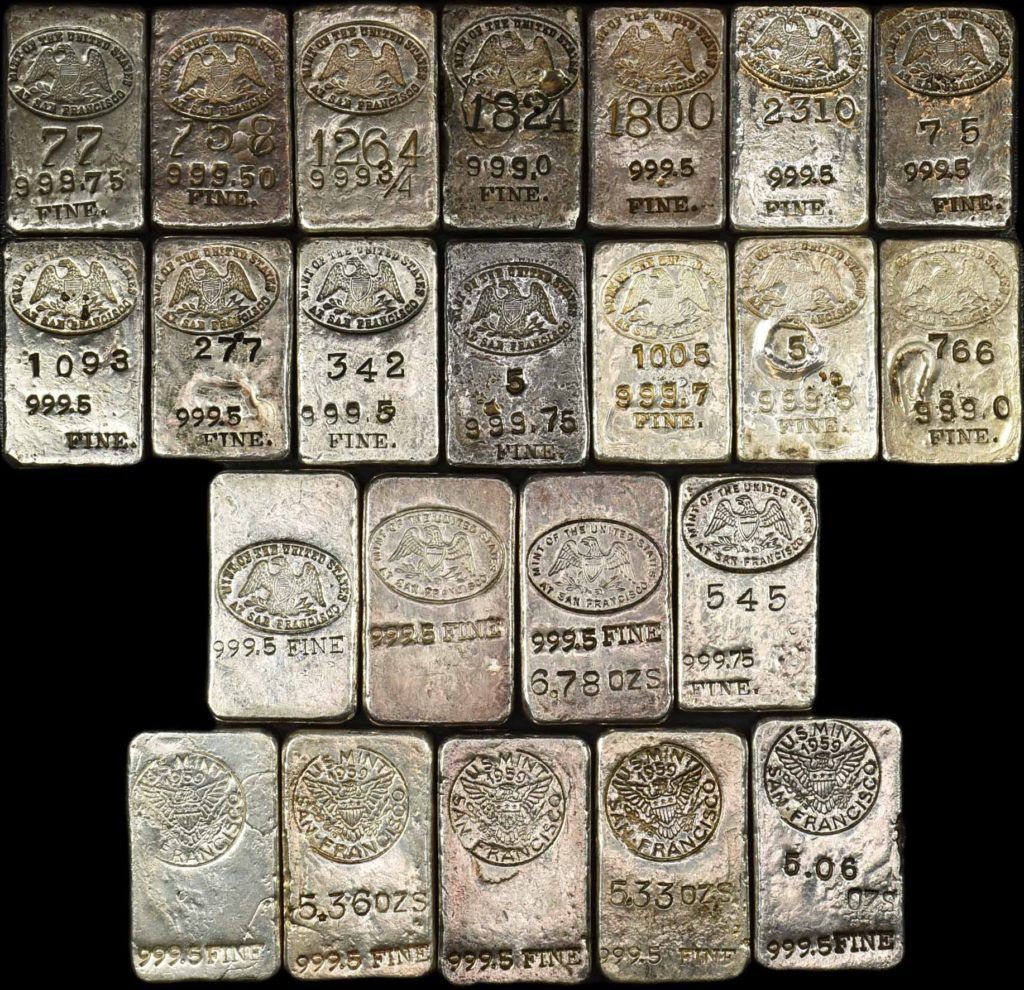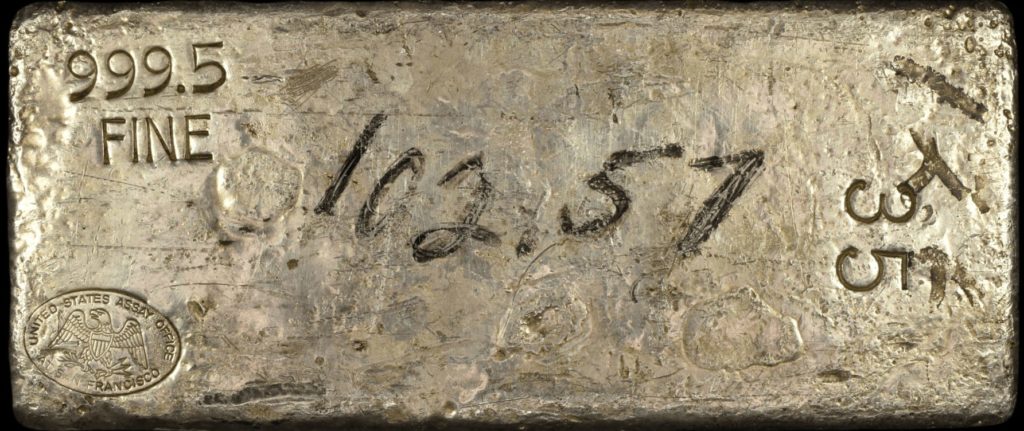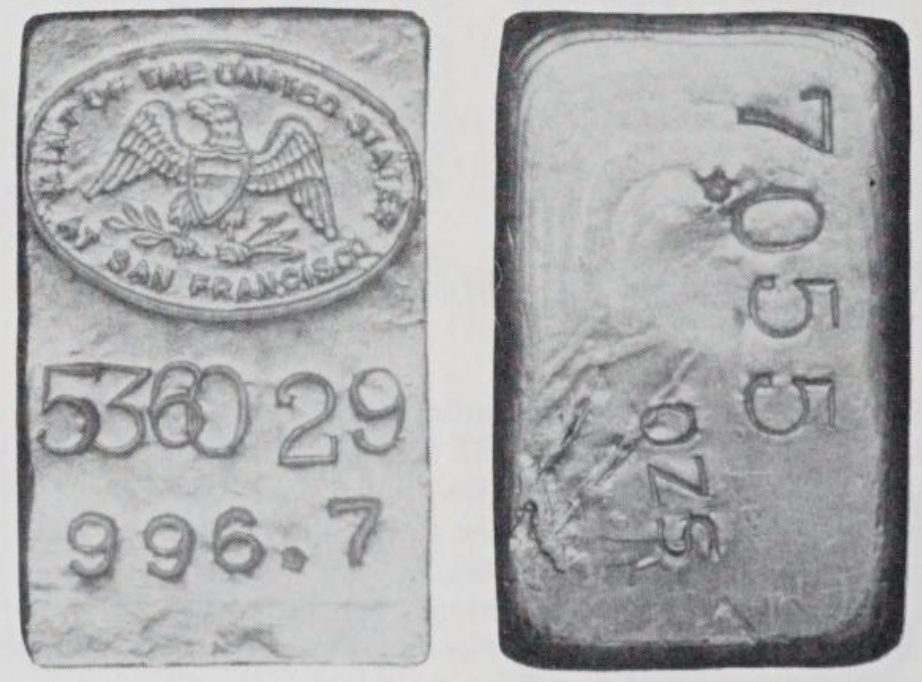While we do not feature San Fran ingots on this size for the most part due to their relative abundance compared to other ingots from 19th century, we present the following information as a guide and helpful resource particularly as they were made by the US Mint.
The San Francisco Mint opened in 1854 to serve the gold mines of the California Gold Rush. Within twenty years, the first building was outgrown and in 1874, the Old United States Mint, was opened. Also known as the Granite Lady, this is one of the few buildings to survive the 1906 San Francisco earthquake. For a very informative read about the Granite Lady, see A Mighty Fortress, The Stories Behind the 2nd San Francisco Mint, by Richard G. Kelly & Nancy Y. Oliver.
This building was in service until 1937 and home to production of the first United Stated Mint San Francisco silver ingots in the early 1930’s. Of all the Mints and Assay Office where United States Government silver ingots were produced, San Francisco produced by far the most, not only in types and series, but also in numbers of each. The United States Mint San Francisco is the only United States Government facility that customers could bring or send in scrap silver for refining and assaying, then obtain silver ingots in return.
FOUR major hallmark types exist:
- Type 1 (Serif Hallmark Text)
- Type 2 (Sans Serif Hallmark Text, no shield lines)
- Type 3a (Larger version of Type 1)
- Type 3b (Larger version of Type 2)
This is not to be confused with the serial font varieties we will discuss later.


Above: Type 1 (left), Type 2 (right)
Here at Rareingot.com, we were the first to identify and name the Type 3a stamp of which there is only one known example to date. Following is a breakdown of the similarities between the Type 1 and Type 3a, as well as Type 2 and Type 3b.
NOTE: The industry has previously only identified the large Oval as a single Type 3. We have further broken this down into two distinct types – the 3a and 3b below.

Above: Type 3a (left), Type 3b (right)
The Type 3a (previously unknown) can be thought of as a much larger Type 1 with the following attributes consistent among both, which are also in contrast with the Type 3b:
- Closed Beak
- Horizontal Shield Lines
- Full Tail Feathers
- Serif Font
- Inset Arrows
- Arrow Feathers Present
- Straight Feet
- Detailed Leaves below Feet
- Sharp Oval Curve
Only one ingot is known to exist with the Type 3a stamp pictured below. It was likely meant as a presentation piece or paperweight and could signify a prototype or transitional period prior to the type 3b.

Above: Type 3a only known example ingot with partial double stamp.
Silver ingots were produced by the United States Mint San Francisco from the early 1930’s through 1960. Later, as the United States Assay Office at San Francisco, silver ingots were again produced from 1962 through the mid to late 1960’s. Despite the number of silver ingots produced between the early 1930’s and the mid to late 1960’s. Very little production documentation supports support chronological organization of the different types and varieties.
Two major hallmarks represent the round logos used in 1950’s and early 60’s: Type 1 (Undated), and Type 2 (Dated).


There are 23 total examples that make up a complete Type set, as shown by Ken Conaway. Four of the type varieties are so rare that only two or three examples are known to exist.

Those 23 unique types can be somewhat summarized thusly:
- Type (1,2) Hallmark, (Large|Medium|Small) Font, (Curved Stem|Straight Stem) Nines, (999.75|999.50|999 3/4, 999.00, 999.5, 999.0) Fine
- Round Hallmark, (With|Wihout) Lot, (With|Without) Weight Stamping
US Assay Office San Francisco
In 1962, the status of the Mint Of The United States At San Francisco was officially changed from mint to assay office. The United States Assay Office At San Francisco operated until March 31, 1988 when mint status was restored. Silver ingot production at the United States Assay Office At San Francisco was concentrated on 100 oz class bars produced for exchange of silver certificates; the exchange program ran from March 1964 to June 24, 1968.
Ultimately these bars would come to be know as Grease Bars. As the demand for silver bullion overwhelmed production capability and standard United States Government precious metal ingot markings fell by the wayside, grease pencil markings of the weight were the only identifying mark.
Originally produced with United States Assay Office At San Francisco oval hallmarks, the first picture represents a very early one with serial number 35, fineness, and the USAO hallmark; The No. 35 bar still shows the original grease pencil weight marking. Over time they dropped the serial number and even the hallmark. Fineness also was increased.

Information above provided largely by Ken Conaway.
For more archived information on the sub-types and varieties you may visit his previous resource at: https://web.archive.org/web/20220117065623/https://silveringots.com/san-francisco/
Earliest Known
The very first silver ingots produced by the Mint Of The United States At San Francisco were the Type I oval hallmark, large font serial number, with curved stem nines in 999.75 fineness. This series is always stamped with the weight on the reverse. The weight and OZS font are consistent throughout the series even though the fineness changes, though exception are found only on the few heavier ingots ( +/-10 oz, +/-25 oz and +/-100 oz) within the numerical range of this series, where the OZS font size is larger. There is no consistent use of lot numbering in this series but Lot 195 shows up on a small range of serial numbers in the low to mid 200’s. The numerical range of this series spans from just a few double digits to the low 1800’s.
Ken dates this series back to the early 1930’s through auction listing descriptions when resales began showing up and one specific donation to the American Numismatic Society from the late David M. Bullowa.
Population
Approximately 621 San Francisco silver ingots have been documented by Ken Conaway in his registry. We estimate the total survival of these to be less than 1000 and likely less than 750 today. From time to time more ingots pop up and continue to increase the number of “known” bars although a registry is no longer actively maintained in public.
7.055 oz Mint of the United States at San Francisco. Gold bar.

Condition about as issued. The face of the bar carries the seal of the mint, the fineness “996.7”, and the serial number “536029.” The back of the bar is stamped with the weight “7.055 OZS.” The bottom edge, relative to the face, is stamped twice with the symbol “100” The top edge is stamped “12.” The dimensions of the ingot are approximately 50mm X 31mm x 5mm.
[01/1990] https://archive.org/details/collectionsofrhg1990bowe/page/166/
